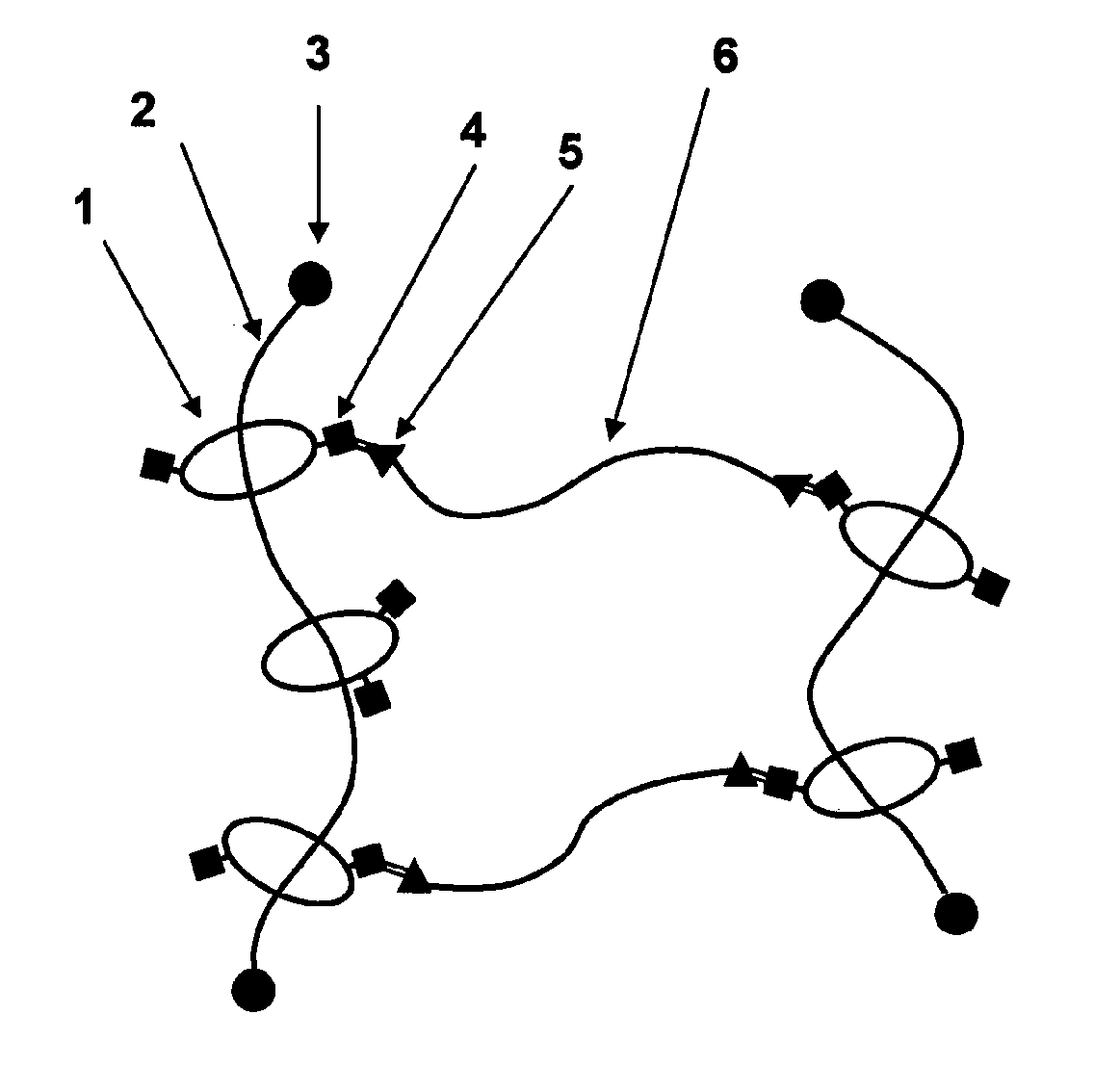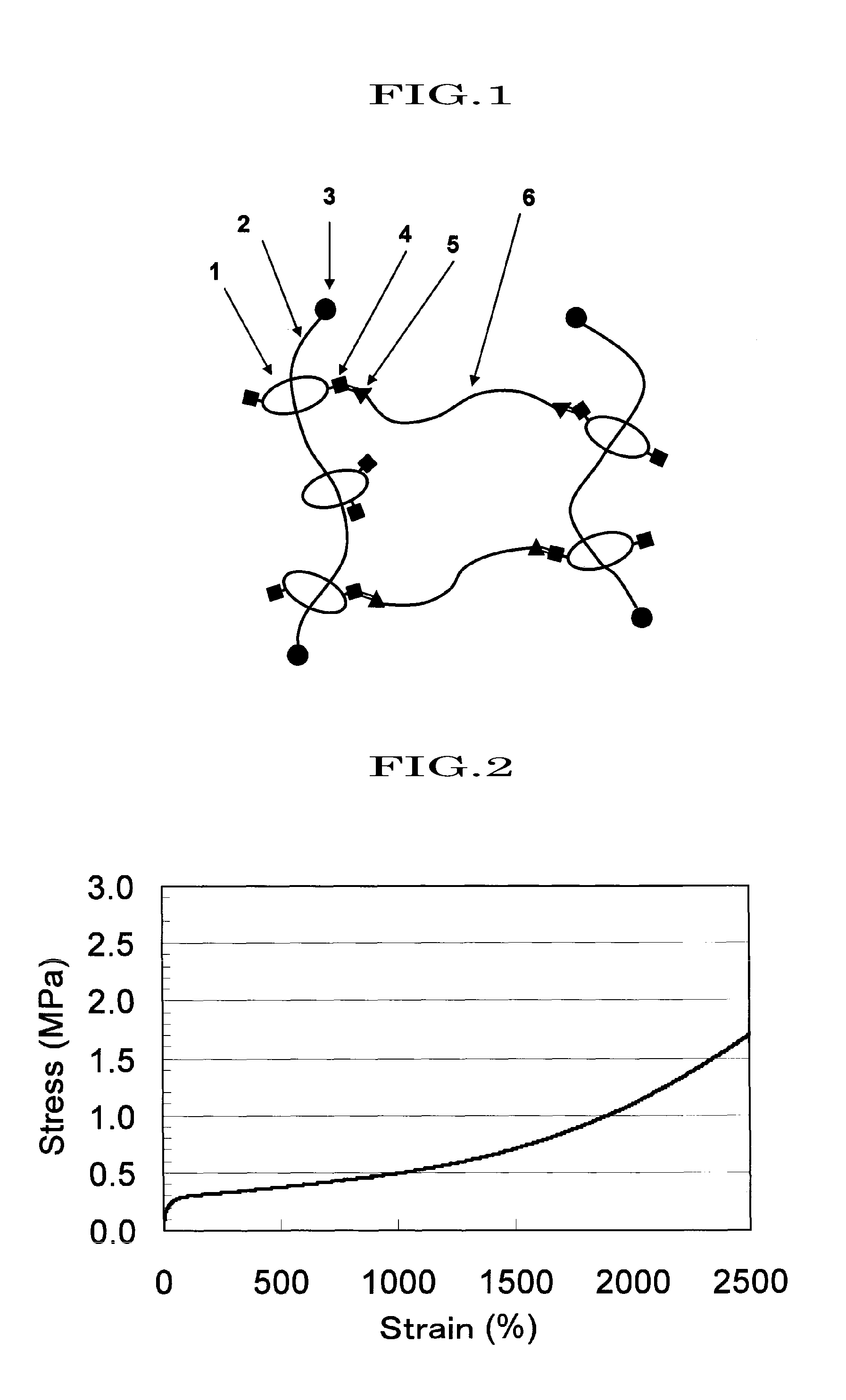Solvent-free crosslinked polyrotaxane material and process for production of same
a crosslinked polyrotaxane and solvent-free technology, applied in the field of solvent-free crosslinked polyrotaxane material and process for production of same, can solve the problem of insufficient characteristics of an application which requires viscoelasticity with higher flexibility, and achieve the effect of wide low-stress region
- Summary
- Abstract
- Description
- Claims
- Application Information
AI Technical Summary
Benefits of technology
Problems solved by technology
Method used
Image
Examples
synthetic example 1
[0151]A compound (hereinafter, abbreviating hydroxypropylated polyrotaxane as “HAPR35”) obtained by hydroxypropylating a polyrotaxane formed of a linear molecule: polyethylene glycol (average molecular weight: 35,000), a cyclic molecule: α-CD, and a capping group: an adamantane amine group was prepared in a manner similar to the method described in WO2005-080469 (whole contents thereof are incorporated herein by reference) (α-CD inclusion amount: 25% determined by 1H-NMR analysis; introduction ratio of hydroxypropyl group: 48%; weight-average molecular weight, Mw determined by GPC: 150,000).
[0152]3.0 g of HAPR35 as obtained above was dissolved in 45 ml of a dehydrated N,N-dimethylacetamide (DMA), 0.6 ml of triethylamine and 0.70 ml of acetic anhydride (25 mol % based on the number of the hydroxyl group in HAPR35) were added in order thereto, and then the reaction was carried out for 5 hours. After that, the solution was added dropwise to hexane (360 ml), and the precipitates were di...
synthetic example 2
[0154]1.0 g of HAPR35 obtained in Synthetic Example 1 was placed in a three-necked flask, and while nitrogen was slowly flowed in, 4.5 g of ε-caprolactone was introduced therein. The mixture was uniformly stirred at 80° C. for 30 minutes using a mechanical stirrer, and then the reaction temperature was raised to 100° C. 0.16 g of tin 2-ethylhexanoate (50 wt % solution) which had been diluted in advance with toluene, was added to the flask, the reaction was continued for 5 hours, and then solvent was removed from the system, to obtain 5.5 g of a reaction product (in which a polycaprolactone group is introduced to HAPR35, and hereinafter, abbreviating “polycaprolactone group introduced to HAPR35” as “HAPR35-g-PCL”) . The product was analyzed by IR, and a peak originating from an ester at 1736 cm−1 was observed. More, GPC determined that the weight average molecular weight, Mw, was 586,800, and the molecular weight distribution, Mw / Mn, was 1.7.
synthetic example 3
[0155]A polyrotaxane (hereinafter, abbreviating the polyrotaxane as “APR35”) formed of a linear molecule: polyethylene glycol (average molecular weight: 35,000), a cyclic molecule: α-CD, and a capping group: an adamantane amine group was prepared in a manner similar to the method described in WO2005-052026 (whole contents thereof are incorporated herein by reference) (α-CD inclusion amount: 25%; weight-average molecular weight, Mw determined by GPC: 110,000).
[0156]10 g of APR35 was placed in a three-necked flask, and then, dissolved in 200 ml of a 4% solution of lithium chloride in dehydrated dimethylformamide. To the resulting solution, 1.7 g of 4-dimetylaminopyridine was added, 4.3 ml of triethylamine and 2.6 ml of acetic anhydride (20 mol % based on the hydroxyl groups in APR35) were added in order, and then the reaction was carried out for 5 hours at room temperature. The reaction solution was dialyzed using a dialysis tube (fractionation molecular weight; 12,000) for 48 hours u...
PUM
| Property | Measurement | Unit |
|---|---|---|
| Fraction | aaaaa | aaaaa |
| Fraction | aaaaa | aaaaa |
| Fraction | aaaaa | aaaaa |
Abstract
Description
Claims
Application Information
 Login to View More
Login to View More - R&D
- Intellectual Property
- Life Sciences
- Materials
- Tech Scout
- Unparalleled Data Quality
- Higher Quality Content
- 60% Fewer Hallucinations
Browse by: Latest US Patents, China's latest patents, Technical Efficacy Thesaurus, Application Domain, Technology Topic, Popular Technical Reports.
© 2025 PatSnap. All rights reserved.Legal|Privacy policy|Modern Slavery Act Transparency Statement|Sitemap|About US| Contact US: help@patsnap.com



